Photo: Winky.
After more than a decade of negotiations, the countries of the United Nations agreed to the first high seas treaty in history to protect the world's oceans beyond national borders and their biological diversity.
Why is this document so important and what is it based on?
The high seas treaty, signed on March 5, aims to convert 30% of the seas into protected areas by the year 2030 to safeguard and recover marine nature.
The last international agreement on the protection of the oceans - the United Nations Convention on the Law of the Sea - was reached 40 years ago, in 1982. It established a zone called the high seas, that is, international waters in which all countries have right to fish, navigate and investigate.
But only 1.2% of these waters were protected, according to the document, which left the marine life in these areas (abalone, sharks, whales, etc.) in danger of exploitation due to threats such as climate change, overfishing and the maritime traffic.
Starting now, however, these new protected areas, established in the treaty, will limit fishing, shipping lanes, and exploration activities, such as deep-sea mining, which can disturb animal breeding areas, generate noise pollution, and be toxic to marine life, according to the BBC.
Among other key measures in the document, it continued, is also the adoption of agreements to share marine genetic resources, such as the biological material of plants and animals in the ocean.
These resources can have benefits for society, such as pharmaceuticals and food.
Stockholm University ocean researcher Dr Robert Blasiak said the challenge is that no one knows how much ocean resources are worth, and therefore how they might be shared between countries.
"If we imagine a widescreen high-definition television, in which only three or four pixels work, that is our knowledge of the ocean depths. We have recorded some 230,000 species in the ocean, but it is estimated that there are more than two million," he exemplified. .
The countries will have to meet again to formally adopt the agreement and then they will have a lot of work to do before the treaty can be implemented.
(Taken from Sputnik)
